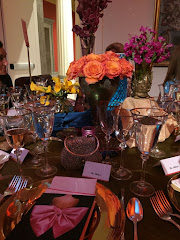- Of course, put the rest of your life on hold. Immediately accept the invitation. Being invited for a meal at the White House is a once in a lifetime opportunity.
- Hand write your response in fine black ink on a fine stationery, folded once. Hand deliver or have delivered by messenger your acceptance as follows:
Mr. and Mrs. William Wordly
have the honor to accept
the kind invitation of
the President and Mrs. Washington
for dinner on Thursday the twenty-sixth of April
at eight o'clock
- Study up on the following forms of service. Each President chooses what type of service to use in his White House. Forms of service include:
- Service a la russe (1860's style) was whole food paraded around the dining room on decorated platters, then taken into the kitchen, cut up and served. Women are served first.
- Service a la russe (Modern style) is a 'gueridon' with a side burner 'rechaud' brought to the table and the dish is prepared in front of the guest. Women are served first. (The Homestead in Virginia still uses this service).
- Service a la anglaise Server presents the arranged platter from left and serves the guests, Women are served first. (This style service allows the host to control the portions offered).
- Service a la francaise Guests serve themselves from the presented platter. Women are presented the platter first. (The Dominican Republic uses this style of service).
- Service American Style Food served already on plate.
- Buffet style service has been recently added to the forms of service used at the White House (former President Clinton added this style of service).
- Arrive at least a few minutes early, and quickly assemble in the Blue Room. Do not linger around in the Foyer or Drawing Room. Exactly like a European court, the President and the First Lady of the Land will descend the Blue Room stairs promptly at eight o'clock.
- When spoken to, one must refer to the President as "Mr. President." One may vary one's answers with "Sir."
- In conversation, always refer to the President as "President Washington", never just plain "Washington," as this practice is considered bad form and is disrespectful of the office.
- Refer to the wife of the President as Mrs. Washington, and treat her as you would any formal hostess.
- Do not sit down until the President and First Lady are seated.
- Touch nothing (not even your napkin) until the President and First Lady place their own napkins on their laps.
- Place cards will dictate where one sits. If the place card is on top of your plate, place it first to your right, then later, to your left. This way, you will be sure to talk to the person on your right and on your left during your meal.
- No one gets up during the meal. Not even to the "Powder Room."
- No alcohol is served during the meal.
- The menu is simple and neutral due to many food allergies.
- Most meals are 4 courses. Each course lasts about 20 minutes. Pace yourself to finish your course neither first nor last.
- There is no bread and butter plate and no bread or butter served (messy).
- Sauces served on foods, if at all, are kept to a minimum (drippy).
- Garlic is never used (lingering bad breath).
- Never leave the table until the President and First Lady have withdrawn from the room.
- After the meal, there may be a different venue such as music in the Music Room, and one may have the chance to have your photograph made with the President. Thanks to the thoughtfully planned menu, one can be sure to have decent breath, and no bread-crumbs or sauce on your clothing.
- Clean or nearly clean your plate, so the chef knows you enjoyed your meal. Roland Mesnier, the Executive Chef for the White House for the past 26 years says: "Plates don't lie." :
The Richmond Times Dispatch, September 14, 2011, article: "Savor The White House" by Holly Prestidge, and the book: "Etiquette" by Emily Post, 1937.









